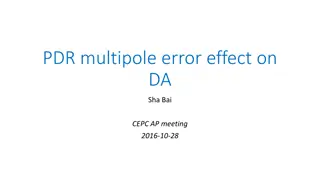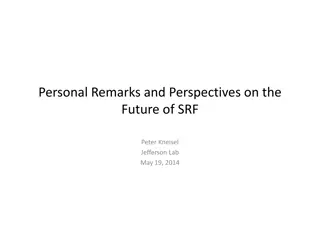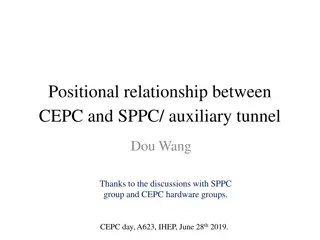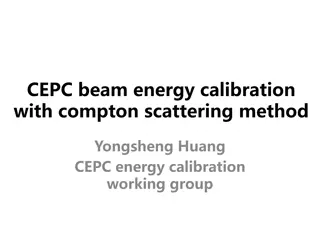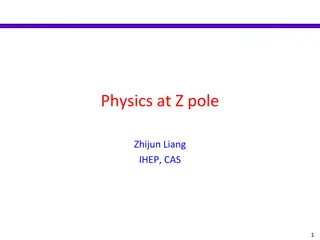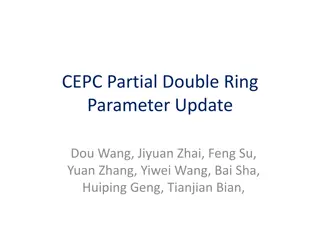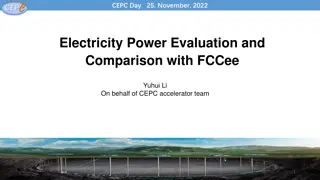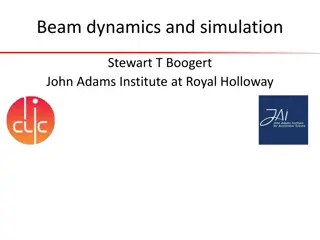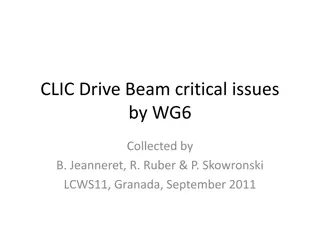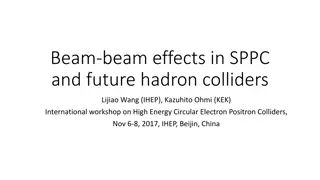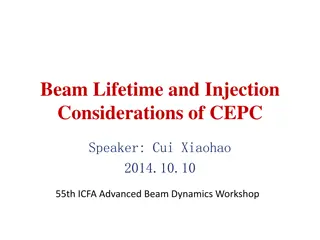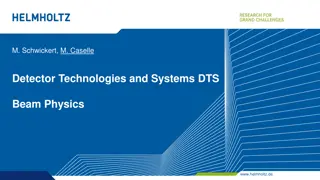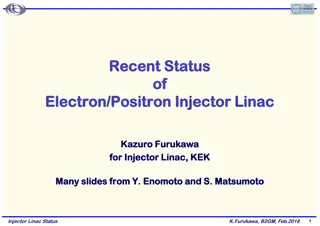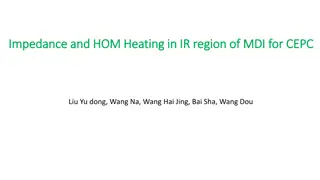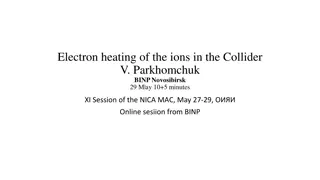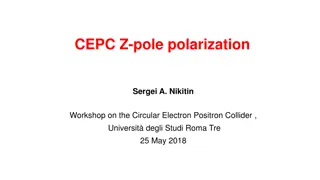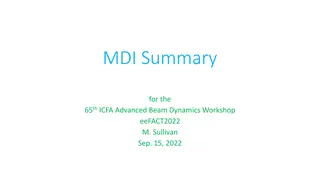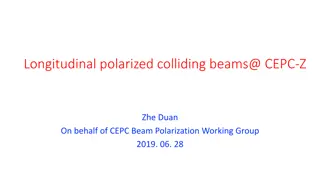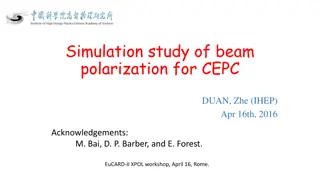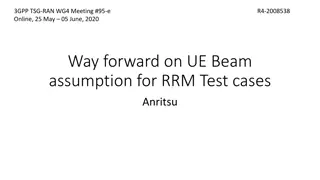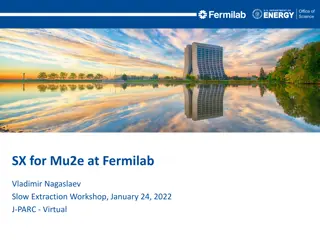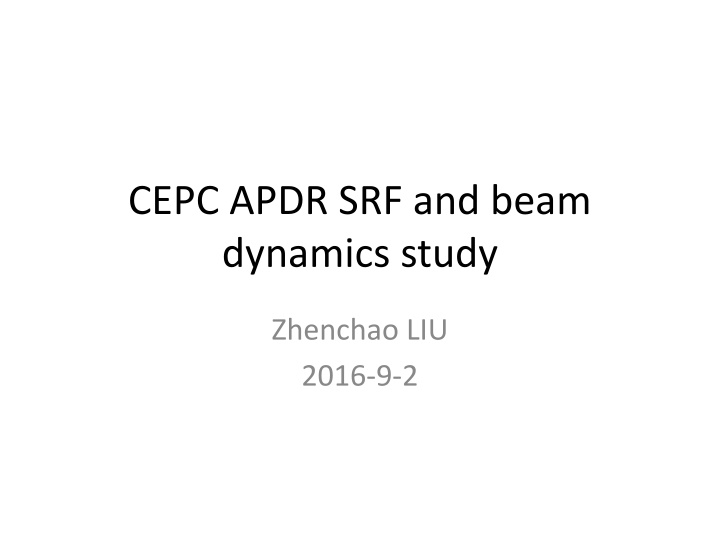
CEPC APDR SRF and Beam Dynamics Study by Zhenchao LIU
Explore the CEPC APDR SRF scheme and beam dynamics study conducted by Zhenchao LIU on September 2, 2016. This study delves into the advantages, problems, and new ideas related to the accelerator, including a new acceleration method for improved RF efficiency.
Download Presentation

Please find below an Image/Link to download the presentation.
The content on the website is provided AS IS for your information and personal use only. It may not be sold, licensed, or shared on other websites without obtaining consent from the author. If you encounter any issues during the download, it is possible that the publisher has removed the file from their server.
You are allowed to download the files provided on this website for personal or commercial use, subject to the condition that they are used lawfully. All files are the property of their respective owners.
The content on the website is provided AS IS for your information and personal use only. It may not be sold, licensed, or shared on other websites without obtaining consent from the author.
E N D
Presentation Transcript
CEPC APDR SRF and beam dynamics study Zhenchao LIU 2016-9-2
Outline APDR SRF scheme Cavity requirement Phase and voltage analysis Booster
Advantage: Avoid pretzel orbit Accommodate more bunches at Z/W energy Reduce AC power with crab waist collision bypass (pp) bypass (pp) Problem: very low RF efficiency!!
New SRF layout-6 ring IP1 RF station Double Ring (1km/3km) C 60km RF&DR center 30 equispaced IP3
bunch 3.3us t 26.7us
Nonconstant Voltage and Phase (NVP) Acceleration method New acceleration method for CEPC to solve RF efficiency The bunches in a bunch train will be accelerated at different Vci The bunches in a bunch train will be accelerated at different synchrotron phase to keep constant energy gain. Vai=Vci*cos si=C
parameter for CEPC partial double ring wangdou20160325 Pre-CDR H-high lumi. H-low power W Z Number of IPs Energy (GeV) Circumference (km) SR loss/turn (GeV) Half crossing angle (mrad) Piwinski angle Ne/bunch (1011) Bunch number Beam current (mA) SR power /beam (MW) Bending radius (km) Momentum compaction (10-5) IPx/y (m) Emittance x/y (nm) Transverse IP(um) x/IP y/IP VRF(GV) fRF(MHz) Nature z(mm) Total z(mm) HOM power/cavity (kw) Energy spread (%) Energy acceptance (%) Energy acceptance by RF (%) n Life time due to beamstrahlung_cal (minute) F (hour glass) Lmax/IP (1034cm-2s-1) 2 2 2 2 2 120 54 3.1 0 0 3.79 50 16.6 51.7 6.1 3.4 120 54 2.96 15 2.5 2.85 67 16.9 50 6.2 2.5 120 54 2.96 15 2.6 2.67 44 10.5 31.2 6.2 2.2 80 54 0.59 15 5 0.74 400 26.2 15.6 6.1 2.4 45.5 54 0.062 15 7.6 0.46 1100 45.4 2.8 6.1 3.5 0.1/0.001 0.62/0.0028 7.9/0.053 0.006 0.073 0.12 650 3.9 4.0 0.99 0.05 0.8/0.0012 6.12/0.018 69.97/0.15 0.118 0.083 6.87 650 2.14 2.65 3.6 0.13 2 6 0.23 47 0.25/0.00136 2.45/0.0074 24.8/0.1 0.03 0.11 3.62 650 3.1 4.1 2.2 0.13 2 2.2 0.47 36 0.268 /0.00124 2.06 /0.0062 23.5/0.088 0.032 0.11 3.53 650 3.0 4.0 1.3 0.13 2 2.1 0.47 32 0.1/0.001 1.02/0.003 10.1/0.056 0.008 0.074 0.81 650 3.25 3.35 0.99 0.09 1.7 0.3 1.1 0.24 0.68 2.04 0.82 2.96 0.81 2.01 0.92 3.09 0.95 3.09 8
6 double ring/ PDR(HL) Zhaijiyuan20160327&04 08 2 120 54 2.96 15 2.5 2.85 67 16.96 51 6.2 3.65 650 384 20.6 35.2 263.4 2220 382.5 2 6 10 64 206 268 0.54 0.8 2 2E10 0.097 1.97e5 3.3 -1.16 107.4 5.484 0.3-160 27% / 1.7 APDR(HL VRF=3.62) 2 120 54 2.96 15 2.5 2.85 22x3 17 50 6.2 3.62 650 384 20.6 35.2-32.3 260 2345 100.4 2 8 8 48 206 268 0.54 0.838 2 2E10 0.811 1.656e6 0.196 -0.138 107.4 5.484 26.7 ~100 3.3 0.0158 APDR (H-low power) 2 120 54 2.96 15 2.6 2.67 15x3 10.5 31.2 6.2 3.53 650 384 20 33-30.9 163 1148 62.7 2 8 8 48 206 268 0.54 0.485 2 2E10 1.242 2.536e6 0.128 -0.083 100 5.484 26.7 ~100 2.2 0.021 Pre-CDR Zhaijiyuan20160327 APDR (Z) Number of IPs Energy (GeV) Circumference (km) SR loss/turn (GeV) Half crossing angle (mrad) Piwinski angle Ne/bunch (1011) Bunch number Beam current (mA) SR power /beam (MW) Bending radius (km) VRF(GV) fRF(MHz) Cavity No. Cavity gradient Accelerating phase CW power/cavity kW Peak power/train (kW) Total Power MW) Cell/cavity Cavity/module Module/station Total module R/Q ( ) G HOM loss factor/cavity (V/pC) HOM power/cavity (kW) Working Temperature K Q0 ms QL Bandwidth(kHz) Detuning F (kHz) Stored energy/cavity(J) Frev(kHz) Gap length (us) (RF to beam efficiency)(%) Vc decrease(%) TB/ 2 2 120 54 3.1 0 0 3.79 50 16.6 53.2 6.1 6.87 650 384 15.8 63.1 275 / 105.6 5 4 6 96 514 268 1.8 3.6 2 4E10 1.156 2.36e6 0.28 -0.27 158.7 5.484 / 100 / / 45.5 54 0.062 15 8.5 0.46 367x3 45.4 2.8 6.1 0.357/0/12 650 48/24 16.2/21.7 80.2-79.8/58.9-56.9 117/233 1237 5.6 2/1 4/4 2/1 12/6 206/103 268 0.54 0.361/0.18 2 2E10 2.243/0.507 4.58e6/1.03e6 0.071/0.314 -0.234/-0.520 65.3/59.1 5.484 26.7 ~100 2.5/5.3 0.012/0.053
Accelerator gradient decrease in one RF cavity (Z) Bunch train passing Bunch train space Assume matching Final Eacc/Initial Eacc Final Eacc/Initial Eacc Initial Eacc(MV/m) RF cycles Field evolution in cavity Field decrease vs. various initial field gradient of the cavity
New SRF layout-8 ring IP1 RF station Double Ring (1km/3km) C 62km RF&DR center 22.5 equispaced IP3
bunch 3.3us t 20us
8 double ring Pre-CDR Zhaijiyuan20 160327 2 120 54 3.1 0 0 3.79 50 16.6 53.2 6.1 6.87 650 384 15.8 63.1 PDR(HL) APDR(HL VRF=3.62) APDR (H-low power VRF=3.53) 2 120 54 2.96 15 2.6 2.67 11x4 10.5 31.2 6.2 3.53 650 384/768/192 20/20/20 33-31.6/33- 31.6/33-31.6 APDR (H- low power) Zhaijiyuan20160 327&0408 2 120 54 2.96 15 2.5 2.85 67 16.96 51 6.2 3.65 650 384 20.6 35.2 APDR (Z) Number of IPs Energy (GeV) Circumference (km) SR loss/turn (GeV) Half crossing angle (mrad) Piwinski angle Ne/bunch (1011) Bunch number Beam current (mA) SR power /beam (MW) Bending radius (km) VRF(GV) fRF(MHz) Cavity No. Cavity gradient 2 2 2 120 54 2.96 15 2.5 2.85 17x4 17 50 6.2 3.62 650 384 20.6 35.2-33 120 54 2.96 15 2.6 2.67 11x4 10.5 31.2 6.2 5.16 650 498 22.6 55.3-55 45.5 54 0.062 15 8.5 0.46 275x4 45.4 2.8 6.1 0.357/0.12/0.12 650 48/16/16 16.2/16.3/32.6 80.1-79.9/58.9- 56.9/58.9-58 Accelerating phase 263.4 2220 382.5 2 6 10 64 206 268 0.54 0.8 2 2E10 0.097 1.97e5 3.3 -1.16 107.4 5.484 0.3-160 27% / 1.7 260 1389 100.4 2 6 8 64 206 268 0.54 0.838 2 2E10 0.811 1.656e6 0.196 -0.138 107.4 5.484 20 ~100 2.5 0.025 163.3/81.6/326.6 843 62.7 2/1/4 6/12/3 8/8/8 64/64/64 206/103/412 268 0.54/0.27/1.08 0.485/0.24/0.97 2 2E10 1.242 2.53e6 0.128 -0.083 100 5.484 20 ~100 1.6 0.0098 126 843 62.7 2 6(3,2) 10(11 126 206 268 0.54 0.485 2 2E10 2.045 4.18e6 0.077 -0.111 126.9 5.484 20 ~100 1 0.0098 117/350/350 884 5.6 2/2/1 6/2/2 1/1/1 8/8/8 206/206/103 268 0.54/0.54/0.27 0.36/0.36/0.18 2 2E10 2.243/0.76/0.76 4.58e6/1.55e6/1.55e6 0.071/0.209/0.209 -0.234/-0.347/-0.347 65.3/65.3/133 5.484 20 ~100 1.7/5.3/2.5 0.0089/0.0263/0.0263 CW power/cavity kW Peak power/train (kW) Total Power MW Cell/cavity Cavity/module Module/station Total module R/Q ( ) G HOM loss factor/cavity (V/pC) HOM power/cavity (kW) Working Temperature K Q0 ms QL Bandwidth(kHz) Detuning F (kHz) Stored energy/cavity(J) Frev(kHz) Gap length TB (us) (RF to beam efficiency)(%) Vc decrease(%) TB/ 275 / 105.6 5 4 6 96 514 268 1.8 3.6 2 4E10 1.156 2.36e6 0.28 -0.27 158.7 5.484 / 100 / /
8 ring H-Low power mode 8 ring H-Low power mode 8 ring Z mode 8 ring Z mode
What is the best number of PDR? Pcw<<Ppulsecase: There are 2n PDR in the circumference n=1,2 ). Voltage decrease(%) Voltage decrease(%) Number of PDR Number of PDR HL mode H-low power mode
What is the best voltage? R/Q=Vc^2/ U, assume Ppulse>>Pcw c V ( ) ( / ) V dN q R Q N = 1 SR cav b 2 V ( ) V N c RF cav d, cavity effective length, q bunch charge, Nbbunches per train, Ncavcavity number. H-low power case: q=42.8nC,Vsr=2.96GV, Ncav=384 Assume matching Vc /Vc Vc /Vc Nb=50 Nb=11 VRF(GV) VRF(V)
What is the best voltage? R/Q=Vc^2/ U, assume Ppulse>>Pcw c V ( ) ( / ) V dN q R Q N = 1 SR cav b 2 V ( ) V N c RF cav d, cavity effective length, q bunch charge, Nbbunches per train, Ncavcavity number. H-low power case: Nb=11,q=42.8nC,Vsr=2.96GV, Assume matching & same gradient Ncav=498 Ncav=384 Vc /Vc Vc /Vc Working VRF Working VRF VRF(V) VRF(V)
LEP Assume: e= 1deg., s=116deg., align=3deg., Ib=0.45mA, h=31324, Q=40000, Rs=774M 14 cavities V0(initial peak voltage)from 20MV-100MV 2.3MV/cavity(acc. voltage) Voltage decrease: Vleft/V0 1 bunch ~1% 4 bunches ~4% APDR: 8 DR: 2.5%(HL)5.3/2.5%(Z) 6 DR: 3.3%(HL) V0(V) Voltage drop is acceptable!
Phase shift Pcw<<Ppulsecase: Larger synchrotron phase will make smaller phase shift for the bunches in a bunch train for the same voltage drop Large voltage drop should choose larger synchrotron phase Large synchrotron phase means more cavities (more cost) 2% Vc decrease of last bunch (degree) Synchrotron phase Phase shift 0% Vc decrease 4% Vc decrease 10% Vc decrease 20% 20% Vc decrease 10% 0% 4% 2% Synchrotron phase of first bunch (degree)
Phase shift Pcw<<Ppulsecase: Larger synchrotron phase will make smaller phase shift for the bunches in a bunch train for the same voltage drop Large voltage drop should choose larger synchrotron phase Large synchrotron phase means more cavities (more cost) Phase shift (degree) 2% Vc decrease 4% Vc decrease 10% Vc decrease 20% Vc decrease Synchrotron phase of first bunch (degree)
CEPC APDR SRF Design APDR SRF Challenge Difficulty Methods CDR 0.1% Phase stability Feedback control, injection control, phase stability, SR damping, 1% Voltage control Feedback control, BBU Variation on bunch current, Low wake field excitation at bunch train length, High damping SC cavity, Radiation damping(wiggler), bunch spacing, feedback, >500mA (Z>1A) HOM damping Single cell beam pipe/slotted cavity(multi-cell), 1-3kW Longitudinal instability Transverse instability Impact bunch position control Input coupler 130kW(1cell),260kW(2cell); Z:350kW(2cell),175kW(1cell) Q0 EP is very important 2E10 20.6MV/m&Q0=2E10@2K ( ) 32.6MV/m&Q0=2E10@2K ( , lower the Q0) Cavity gradient H mode:2E10 Z mode:> 5E9
What is the best =4366 = =0.3 P-/P+ P-/P+ 0.2 0.3 0.4 =1 0.6 0.8 t/ t/ P-, reflection power; P+, forward power.
What is the best cavity for APDR? R/Q=Vc2/ U A lower R/Q can give a high U at the same cavity voltage (or gradient) The gradient is more stable at higher U when the input power is not enough at the pulse period. It is an opposite design scheme comparing with low-loss cavity or others Reduced R/Q can also decrease the detuning frequency R/Q Riris loss factor Cavity can work at a lower gradient with the same U
Power coupling Phasor diagram s 0 & g> 0
Optimum coupling With optimum coupling condition ig Vb Vc s ib Vg =- s
Equispaced bunches For equispaced bunches: I R V~ i 0 + - cos a e b 1 Consider H-Low power case, I0=0.021mA,Ra=206x2x1010, beta=7.9x103, =-33deg.=-0.576 Vb=0.021x206x2x1010xcos(-0.576)e-0.576i/(1+7.9x103)=-7.7x106+5x106i The amplitude of Vbis 9.2MV Abs(Vb)=9.2MV Angle(Vb)=-0.576 Vc=20MV/m*0.46m=9.2MV, s=0.576 So, Vb=Vc& =- s
APDR bunches Bunch train case, Tb is the bunch time interval in bunch train; TB is the time interval between bunch trains. Tb TB. Tb<<TB&TB/td<<1 Tb/td=2.428e-4, TB/td=0.016, s=33deg., f=650MHz Tb TB
What is beam loading It is not a beam in the cavity!!! It is the beam induced voltage in the cavity!!! When TB/Td<<1, the multi-bunches induced a constant Vb
Non-equispaced bunches Consider H-Low power case, it is equal to 11x4bunches, I0=0.021mA/11=1.91x10-3mA, Ra=206x2x1010, beta=7.9x103, =-33deg.=- 0.576, f=650MHz, t b=196x77/f=2.322x10-5s, Q0=2x1010 = . 1 = ' b 4 V t 865 10 V h R I 0 ih h 2 Q 0 Phase shift is 1.4deg. with 11 bunches, the phase shift between two bunches is 0.14deg. mb=196. So tb=195.999611/f=3.015x10-7s. 2 = b h m t = 3 . 2 - 444 10 b Also we need to assume there is no phase shift between the first bunch of each bunch train. . . 0.14deg. . Bunch 2 Bunch 1 . 196x2
Vbr=Vih*A Im(A) 65 circles ~0.012s Re(A) T (tb) T (tb) One circle=308tb
Vbr=Vih*A, A for bunches in a bunch train after 400000 circles. Total phase shift of Vbis 1.37degree for 11 bunches. Im(A) Re(A) Bunch Bunch Vbr 1.865x104Vx584.5=1.09x107V With optimum matching of minimum Pg, =- s Vb=Vbrcos(-33 )=9.14MV As Vc=9.2MV, so Vb Vc
Vg Vg Angle shift (deg.) 8-ring Bunch No. Vg Angle (deg.) Re Vb Im Vb Re Vc Im Vc Re Vg Im Vg ABS Vg Vg -7.67E+06 4.98E+06 7.72E+06 5.01E+06 1.54E+07 3.05E+04 1.539E+07 1.0000 0.00 0 1 -7.66E+06 5.00E+06 7.72E+06 4.99E+06 1.54E+07 -6.31E+03 1.537E+07 0.9991 -0.13 0 2 -7.64E+06 5.02E+06 7.72E+06 4.97E+06 1.54E+07 -4.31E+04 1.536E+07 0.9983 -0.27 0 3 -7.63E+06 5.03E+06 7.72E+06 4.95E+06 1.53E+07 -7.98E+04 1.535E+07 0.9974 -0.41 0 4 -7.62E+06 5.05E+06 7.72E+06 4.94E+06 1.53E+07 -1.16E+05 1.533E+07 0.9966 -0.54 0 5 -7.60E+06 5.07E+06 7.72E+06 4.92E+06 1.53E+07 -1.53E+05 1.532E+07 0.9958 -0.68 0 6 -7.59E+06 5.09E+06 7.72E+06 4.90E+06 1.53E+07 -1.89E+05 1.531E+07 0.9949 -0.82 0 7 -7.58E+06 5.10E+06 7.72E+06 4.88E+06 1.53E+07 -2.26E+05 1.530E+07 0.9941 -0.96 0 8 -7.56E+06 5.12E+06 7.72E+06 4.86E+06 1.53E+07 -2.62E+05 1.528E+07 0.9933 -1.09 0 9 -7.55E+06 5.14E+06 7.72E+06 4.84E+06 1.53E+07 -2.98E+05 1.527E+07 0.9924 -1.23 0 10 -7.54E+06 5.16E+06 7.72E+06 4.82E+06 1.53E+07 -3.34E+05 1.526E+07 0.9916 -1.37 0 11
Phase evolution With optimum coupling condition (H low power 8ring) ig Vb11 Vc=9.2MV Vb1 Vc1 Vb=9.2MV Vc11 s Vg=15.43MV Vg1 ib 1.37degree Vg11 =- s
Bunch No. Pre CDR (CW, Pg=Pavg) PDR (CW, Pg=Ppulse, very low RF efficiency) APDR 8 ring (HL, CW, Pg=Pavg) APDR 8 ring (H- low power, CW, Pg=Pavg) APDR 8 ring (Z, Pg=Pavg) Vc Phase shift Vc Phase shift Vc Phase shift Vc Phase shift Vc Phase shift 1 2.00 1 1.40 1 2.0000 1 1 0 1 0 0.9984 1.88 0.9984 1.26 0.9998 1.9927 2 1 0 1 0 0.9969 1.75 0.9968 1.12 0.9996 1.9855 3 1 0 1 0 0.9953 1.63 0.9952 0.98 0.9994 1.9782 4 1 0 1 0 0.9938 1.50 0.9936 0.84 0.9992 1.9709 5 1 0 1 0 0.9922 1.38 0.992 0.70 0.9990 1.9636 6 1 0 1 0 0.9906 1.25 0.9904 0.56 0.9988 1.9564 7 1 0 1 0 0.9891 1.13 0.9888 0.42 0.9987 1.9491 8 1 0 1 0 0.9875 1.00 0.9872 0.28 0.9985 1.9418 9 1 0 1 0 0.9859 0.88 0.9856 0.14 0.9983 1.9345 10 1 0 1 0 0.9844 0.75 0.984 0 0.9981 1.9273 11 1 0 1 0 0.9781 0.25 0.9973 1.8982 1 0 1 0 15 0.9750 0.9969 1.8836 1 0 1 0 0 17 0.9906 1.6436 1 0 1 0 50 0.9873 1.5200 1 0 67 0.0947 0 275 Assume Vrfis constant at the first bunch of bunch trains and the change of Vbis negligible.
Bunch No. Pre CDR (CW, Pg=Pavg) PDR (CW, Pg=Ppulse, very low RF efficiency) APDR 6 ring (H- low power, CW, Pg=Pavg) APDR 6 ring (HL, CW, Pg=Pavg) APDR 6 ring (Z, Pg=Pavg) Vc Phase shift Vc Phase shift Vc Phase shift Vc Phase shift Vc Phase shift 1 2.20 1 2.60 1 2.6000 1 1 0 1 0 0.9984 2.04 0.9984 2.48 0.9998 2.5929 2 1 0 1 0 0.9968 1.89 0.9969 2.35 0.9996 2.5858 3 1 0 1 0 0.9952 1.73 0.9953 2.23 0.9994 2.5787 4 1 0 1 0 0.9936 1.57 0.9937 2.10 0.9992 2.5716 5 1 0 1 0 0.992 1.41 0.9921 1.98 0.9989 2.5645 6 1 0 1 0 0.9904 1.26 0.9906 1.86 0.9987 2.5574 7 1 0 1 0 0.9888 1.10 0.9890 1.73 0.9985 2.5503 8 1 0 1 0 0.9872 0.94 0.9874 1.61 0.9983 2.5432 9 1 0 1 0 0.9856 0.79 0.9859 1.49 0.9981 2.5361 10 1 0 1 0 0.984 0.63 0.9843 1.36 0.9979 2.5290 11 1 0 1 0 0.9776 0 0.9780 0.87 0.9971 2.5005 1 0 1 0 15 0.9670 0.9956 2.4508 1 0 1 0 0 22 0.9897 2.2519 1 0 1 0 50 0.9861 2.1311 1 0 67 0.0923 0 367 Assume Vrfis constant at the first bunch of bunch trains and the change of Vbis negligible.
Bunch position The e+ and e- bunch trains should be symmetry to the two IPs. The phase shift of the synchrotron phase between each bunch in a bunch train is 0.14 degree for the H low power mode. The total phase shift is 1.4 degree. After enough synchrotron damping, the bunches will be at its synchrotron phase separately. If the transport matrix from cavity to IP is the same for e+ and e- bunch trains, there will be no shift for the position of colliding. RADIATION DAMPING, R.P. Walker
Power reflection In resonant operation = P P P P r g c b For heavy beam loading, Pc<<Pb, P P P r g b For APDR steady state, Pbis constant. We make the first bunch of bunch train at optimal coupling, then Pg=Pb. Pr=0 The generator power is Which simplifies to H. Padamsee, RF superconductivity for accelerators, P387,P396
The first bunch of bunch train working at different synchrotron phase The beam induced voltage and generator induced voltage are related with . Vc can be increased by lower . By increasing Vc and s, keeping Vc*cos ( s)=C, Pb is constant, Pg is constant. So = 0 P P P r g b
Bunches in a bunch train In we set the optimal to the first bunch, then the is not optimal to others. For example, H low power case, If we set =7914 for the first bunch, keeping Pbconstant (161.5kW). Pc=20.42W Eacc=20MV/m. The last bunch, Pc=19.8W The Pg needed for the last bunches is a little higher. But only 0.025% Pg (W) Last bunch 1stbunch Pc (W)
Booster Parameters Parameter List for Alternating Magnetic Field Scheme. Parameter Unit Value Parameter Unit Value Beam energy [E] GeV 6 RF voltage [Vrf] GV 0.2138 Circumference [C] km 63.84 RF frequency [frf] GHz 1.3 Revolutionfrequency[f0] kHz 4.69 Harmonic number [h] 276831 SR power / beam [P] MW 2.16 Synchrotronoscillationtune[ns] 0.21 Beam off-set in bend cm 1.2 Energy acceptance RF % 5.93 Momentum compaction factor[ ] 2.33E-5 SR loss / turn [U0] GeV 5.42E-4 Strength of dipole Gs -129.18/+180.84 Energyspread[sd] inequilibrium % 0.0147 nB/beam 50 injected from linac % 0.1 Lorentz factor [g] 11741.71 Bunch length[sd] inequilibrium mm 0.18 Magnetic rigidity [Br] T m 20 injected from linac mm ~1.5 Beam current / beam [I] mA 0.92 Transversedampingtime[tx] ms 4.71 Bunchpopulation[Ne] 2.44E10 turns Bunch charge [Qb] nC 3.91681 Longitudinaldampingtime[te] ms 4.71 emittance-horizontal[ex] inequilibrium m rad 6.38E-11 turns injected from linac m rad 3E-7 emittance-vertical[ey] inequilibrium m rad 0.191E-11 3E-7 injected from linac m rad Tianjian Bian
Booster Parameters Parameter List for Alternating Magnetic Field Scheme. Parameter Unit Value Parameter Unit Value Beam energy [E] GeV 120 RF voltage [Vrf] GV 6 Circumference [C] km 63.84 RF frequency [frf] GHz 1.3 Revolutionfrequency[f0] kHz 4.69 Harmonic number [h] 276831 SR power / beam [P] MW 2.16 Synchrotronoscillationtune[ns] 0.21 Beam off-set in bend cm 0 Energy acceptance RF % 4.57 Momentum compaction factor[ ] 2.54E-5 SR loss / turn [U0] GeV 2.34 Strength of dipole Gs 516.71 Energyspread[sd] inequilibrium % 0.12 nB/beam 50 injected from linac % 0.1 Lorentz factor [g] 234834.15 Bunch length[sd] inequilibrium mm 1.36 Magnetic rigidity [Br] T m 400 injected from linac mm ~1.5 Beam current / beam [I] mA 0.92 Transversedampingtime[tx] ms 21.76 Bunchpopulation[Ne] 2.44E10 Bunch charge [Qb] nC 3.91681 Longitudinaldampingtime[te] ms emittance-horizontal[ex] inequilibrium m rad 3.61E-9 injected from linac m rad 3E-7 emittance-vertical[ey] inequilibrium m rad 0.1083E-9 3E-7 injected from linac m rad Tianjian Bian
Synchrotron Phase Inject phase (6 Gev) 89.855 Extract phase (120 GeV 67.046 Synchrotron phase s=arccos(Vsr/Vrf) Assume Vrf linearly increases Synchrotron phase (degree) Beam energy (GeV)
Conclusion The 8-double ring and 6-double ring are available when using the same parameter as PDR(VRF=3.62GV) for HL. The 8-double ring has a lower phase variation than the 6-double ring . The phase region is from 35.2-33 degree for bunches in a bunch train for the 8-double ring HL mode. The phase region is from 35.2- 32.3 degree for the 6-double ring HL mode. The bunch energy gain in each cavity is constant. The RF to beam efficiency is ~100%. Vbis 9.14MV with a 1.37deg. phase shift in a bunch train of the APDR H low power of 8 ring case. Vbreaches constant value after about 65 circles (Ib=C, ~0.012s). Beam can be stored by increasing bunch charges stably (with reflection in low current). Vcshould keep constant phase and value for each bunch separately.

